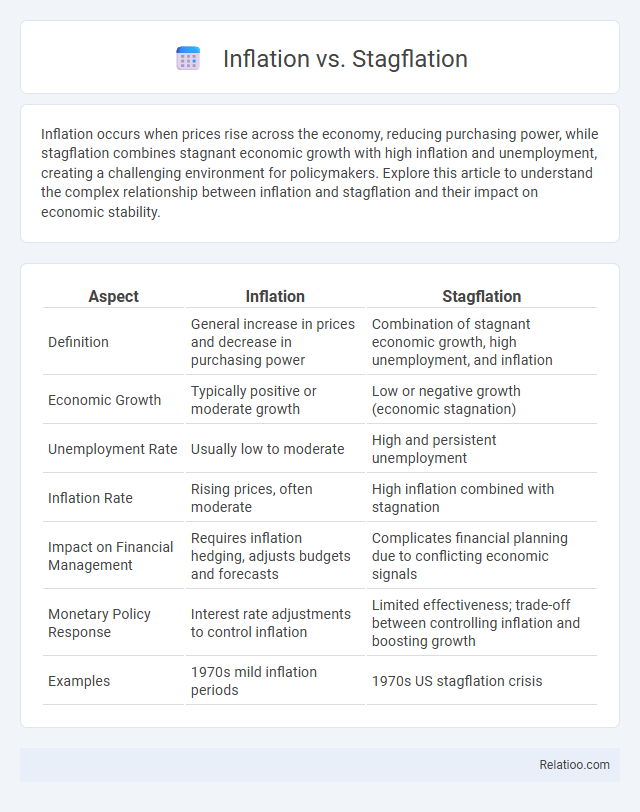Inflation occurs when prices rise across the economy, reducing purchasing power, while stagflation combines stagnant economic growth with high inflation and unemployment, creating a challenging environment for policymakers. Explore this article to understand the complex relationship between inflation and stagflation and their impact on economic stability.
Table of Comparison
| Aspect | Inflation | Stagflation |
|---|---|---|
| Definition | General increase in prices and decrease in purchasing power | Combination of stagnant economic growth, high unemployment, and inflation |
| Economic Growth | Typically positive or moderate growth | Low or negative growth (economic stagnation) |
| Unemployment Rate | Usually low to moderate | High and persistent unemployment |
| Inflation Rate | Rising prices, often moderate | High inflation combined with stagnation |
| Impact on Financial Management | Requires inflation hedging, adjusts budgets and forecasts | Complicates financial planning due to conflicting economic signals |
| Monetary Policy Response | Interest rate adjustments to control inflation | Limited effectiveness; trade-off between controlling inflation and boosting growth |
| Examples | 1970s mild inflation periods | 1970s US stagflation crisis |
Definition of Inflation
Inflation is the general increase in prices and fall in the purchasing value of money over time, impacting the cost of goods and services across an economy. Stagflation occurs when inflation rises alongside stagnant economic growth and high unemployment, creating a challenging environment for policymakers. Understanding these concepts helps you navigate economic changes and make informed financial decisions.
Understanding Stagflation
Stagflation is a unique economic condition characterized by the coexistence of high inflation, stagnant economic growth, and rising unemployment, creating challenges that differ from standard inflation scenarios where growth rates are typically stable or positive. Unlike inflation, which involves a general increase in prices often accompanied by robust economic activity, stagflation represents a troubling combination that complicates monetary policy as efforts to curb inflation might exacerbate unemployment. Understanding stagflation requires analyzing factors such as supply shocks, poor fiscal policies, and wage-price spirals that disrupt the balance between demand and supply, leading to prolonged economic stagnation alongside persistent inflation.
Key Differences Between Inflation and Stagflation
Inflation refers to the general increase in prices and decrease in purchasing power over time, typically driven by demand-pull or cost-push factors. Stagflation, on the other hand, combines high inflation with stagnant economic growth and high unemployment, making it a unique and challenging economic condition. Understanding these distinctions helps you grasp how inflation impacts the economy differently when paired with stagnation and rising joblessness.
Causes of Inflation
Inflation primarily arises from demand-pull factors where increased consumer demand outpaces supply, cost-push factors including rising wages and raw material prices, and built-in inflation driven by adaptive expectations of future price increases. Stagflation combines persistent inflation with stagnant economic growth and high unemployment, often triggered by supply shocks such as oil price spikes and ineffective monetary policies. Understanding these causes is crucial for distinguishing typical inflation scenarios from stagflation's complex economic challenges.
Causes of Stagflation
Stagflation occurs when high inflation combines with stagnant economic growth and rising unemployment, deviating from typical inflation scenarios driven by demand-pull factors. Your understanding of stagflation's causes should focus on supply-side shocks, such as sudden increases in oil prices or disruptions in supply chains, which reduce productivity and drive up costs. Unlike standard inflation, stagflation presents a complex challenge because it merges inflationary pressures with economic stagnation, making monetary policy less effective.
Economic Indicators: Inflation vs Stagflation
Inflation is characterized by a general increase in prices accompanied by rising demand and economic growth, reflected in indicators such as the Consumer Price Index (CPI) and Gross Domestic Product (GDP). Stagflation uniquely combines high inflation with stagnant economic growth and high unemployment rates, making it evident through simultaneous rises in CPI and unemployment figures alongside stagnant or negative GDP growth. Evaluating these economic indicators helps differentiate standard inflationary periods from the more complex and challenging conditions of stagflation.
Impact on Consumers and Businesses
Inflation erodes purchasing power by increasing prices, leading consumers to cut back on discretionary spending while businesses face higher input costs and may raise prices or reduce profit margins. Stagflation combines stagnant economic growth with high inflation, intensifying challenges as consumers experience rising prices without wage growth, and businesses struggle with reduced demand and elevated costs simultaneously. During inflationary periods, consumers adjust budgets and prioritize essentials, whereas businesses focus on cost control, investment strategies, and pricing adjustments to maintain profitability.
Historical Examples of Inflation and Stagflation
The 1970s United States experienced significant stagflation characterized by high inflation rates exceeding 10% combined with stagnant economic growth and rising unemployment following the 1973 oil crisis. In contrast, the hyperinflation in Weimar Germany during the early 1920s saw inflation rates soaring to astronomical levels above 29,500% monthly, but it occurred without the simultaneous stagnation of economic output typical of stagflation. Historical instances demonstrate that inflation involves rising prices often linked to demand-pull or cost-push factors, while stagflation uniquely combines price inflation with economic stagnation and joblessness, complicating monetary policy responses.
Policy Responses to Inflation and Stagflation
Policy responses to inflation typically involve tightening monetary policy through interest rate hikes and reducing money supply to curb rising prices. In contrast, stagflation, characterized by high inflation combined with stagnant economic growth and unemployment, requires a more nuanced approach that balances controlling inflation without worsening unemployment, often involving targeted fiscal measures and structural reforms. Your strategy should consider these distinctions to effectively address inflationary pressures while supporting economic stability.
Future Outlook: Managing Inflation and Stagflation
Managing inflation and stagflation requires strategic monetary policies that balance interest rate adjustments with fiscal measures to stabilize prices and stimulate growth. You should prioritize diversifying investments and maintaining flexible budgets to mitigate risks associated with persistent inflation or stagnant economic conditions. Expert forecasts emphasize innovation and supply chain improvements as key factors to control inflationary pressures while fostering economic resilience in the coming years.

Infographic: Inflation vs Stagflation
 relatioo.com
relatioo.com